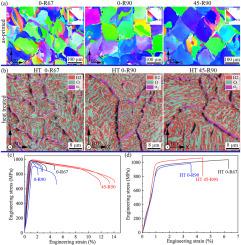激光扫描策略对Ti2AlNb金属间合金显微组织和力学性能的影响
IF 4.8
2区 材料科学
Q2 CHEMISTRY, PHYSICAL
引用次数: 0
摘要
研究了激光扫描策略对激光粉末床熔合制备低延性Ti2AlNb金属间合金(PBF-LB/M)显微组织和力学性能的影响。在其他PBF-LB/M参数保持不变的情况下,采用三种双向线性扫描策略:67°旋转(0-R67)、90°旋转(0-R90)和45°倾斜后90°旋转(45- r90)。成功制备了具有0.01%孔隙率的高质量合金样品,无明显的未熔合缺陷和裂纹。打印的微观结构主要由单一的B2/β相组成,晶粒尺寸受扫描策略的影响,但织构基本保持不变。45-R90样品的屈服强度最高(980 MPa),伸长率最高(13.1%),这是由于残余应力降低,施密特系数(SF)较高且集中。热处理(HT:固溶处理、水淬和时效)后,所有样品均保持B2/β晶粒形态,α2相沿晶界形成,O相分布在晶粒内。HT 0-R67样品表现出最佳的强度-塑性组合(1066 MPa, 5.47%),这主要归功于随机取向的B2/β-晶界、薄的α2相和最低的平均SF。这些发现强调了激光扫描策略在Ti2AlNb合金在印刷和热处理条件下裁剪微观结构和优化性能方面的关键作用。本文章由计算机程序翻译,如有差异,请以英文原文为准。

Impact of laser scanning strategies on microstructure and mechanical properties of Ti2AlNb intermetallic alloy
This study investigates the effects of laser scanning strategies on the microstructure and mechanical properties of the low-ductility Ti2AlNb intermetallic alloy fabricated via laser-based powder bed fusion of metals (PBF-LB/M). Three bidirectional linear scanning strategies—67° rotation (0-R67), 90° rotation (0-R90), and 45° inclined followed by 90° rotation (45-R90) between adjacent layers—were employed, with all other PBF-LB/M parameters held constant. High-quality alloy samples with <0.01 % porosity, free of visible lack-of-fusion defects and cracks, were successfully fabricated. The as-printed microstructures predominantly consisted of a single B2/β phase, with grain size influenced by the scanning strategy, although texture remained largely unchanged. The 45-R90 sample demonstrated the highest yield strength (980 MPa) and best elongation (13.1 %), attributed to reduced residual stress and a higher, concentrated Schmidt Factor (SF). After heat treatment (HT: solution treatment, water quenching, and ageing), all samples retained the B2/β grain morphology, with α2 phases forming along grain boundaries and O phases distributed within the grains. The HT 0-R67 sample exhibited the best strength-ductility combination (1066 MPa, 5.47 %), attributed to randomly oriented B2/β-grain boundaries, thin α2 precipitates, and the lowest average SF of the O phase precipitates. These findings highlight the critical role of laser scanning strategies in tailoring microstructure and optimizing the performance of Ti2AlNb alloys in both as-printed and heat-treated conditions.
求助全文
通过发布文献求助,成功后即可免费获取论文全文。
去求助
来源期刊

Intermetallics
工程技术-材料科学:综合
CiteScore
7.80
自引率
9.10%
发文量
291
审稿时长
37 days
期刊介绍:
This journal is a platform for publishing innovative research and overviews for advancing our understanding of the structure, property, and functionality of complex metallic alloys, including intermetallics, metallic glasses, and high entropy alloys.
The journal reports the science and engineering of metallic materials in the following aspects:
Theories and experiments which address the relationship between property and structure in all length scales.
Physical modeling and numerical simulations which provide a comprehensive understanding of experimental observations.
Stimulated methodologies to characterize the structure and chemistry of materials that correlate the properties.
Technological applications resulting from the understanding of property-structure relationship in materials.
Novel and cutting-edge results warranting rapid communication.
The journal also publishes special issues on selected topics and overviews by invitation only.
 求助内容:
求助内容: 应助结果提醒方式:
应助结果提醒方式:


